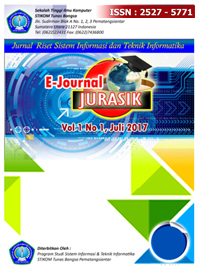Algoritma Naïve Bayes Dalam Memprediksi Kepuasan Nasabah
Abstract
Full Text:
PDFReferences
T. P. Kiling, “PERAN KOMUNIKASI FRONTLINER DALAM MENINGKATKAN PELAYANAN DI PT BNI (PERSERO) TBK KANTOR LAYANAN KAWANGKOAN,” e- journal “Acta Diurna,” vol. V, no. 3, 2016.
M. G. Sadewo, A. P. Windarto, and D. Hartama, “Penerapan Datamining Pada Populasi Daging Ayam Ras Pedaging Di Indonesia Berdasarkan Provinsi Menggunakan K-Means,” InfoTekJar (Jurnal Nasional Informatika dan Teknologi Jaringan), vol. 2, no. 1, pp. 60–67, 2017.
Bustami, “Penerapan Algoritma Naive Bayes untuk Mengklasifikasi Data Nasabah Asuransi,” Jurnal Penelitian Teknik Informatika Universitas Ahmad Dahlan (TECHSI), no. 1, pp. 128–146, 2014.
W. Muslehatin, M. Ibnu, and Mustakim, “Penerapan Naïve Bayes Classification untuk Klasifikasi Tingkat Kemungkinan Obesitas Mahasiswa Sistem Informasi UIN Suska Riau,” Seminar Nasional Teknologi Informasi, Komunikasi dan Industri (SNTIKI), pp. 18–19, 2017.
A. Saleh, “Implementasi Metode Klasifikasi Naïve Bayes Dalam Memprediksi Besarnya Penggunaan Listrik Rumah Tangga,” no. January 2015, 2016.
I. Parlina, A. P. Windarto, A. Wanto, and M. R. Lubis, “Memanfaatkan Algoritma K-Means dalam Menentukan Pegawai yang Layak Mengikuti Asessment Center untuk Clustering Program SDP,” CESS (Journal of Computer Engineering System and Science), vol. 3, no. 1, pp. 87–93, 2018.
R. W. Sari, A. Wanto, and A. P. Windarto, “Implementasi Rapidminer dengan Metode K-Means (Study Kasus : Imunisasi Campak pada Balita Berdasarkan Provinsi),” KOMIK (Konferensi Nasional Teknologi Informasi dan Komputer), vol. 2, no. 1, pp. 224–230, 2018.
S. Sudirman, A. P. Windarto, and A. Wanto, “Data Mining Tools | RapidMiner : K-Means Method on Clustering of Rice Crops by Province as Efforts to Stabilize Food Crops In Indonesia,” IOP Conference Series: Materials Science and Engineering, vol. 420, no. 12089, pp. 1–8, 2018.
A. P. Windarto, “Implementation of Data Mining on Rice Imports by Major Country of Origin Using Algorithm Using K-Means Clustering Method,” International Journal of artificial intelligence research, vol. 1, no. 2, pp. 26–33, 2017.
A. P. Windarto, “Penerapan Data Mining Pada Ekspor Buah-Buahan Menurut Negara Tujuan Menggunakan K-Means Clustering,” Techno.COM, vol. 16, no. 4, pp. 348–357, 2017.
M. G. Sadewo, A. P. Windarto, and A. Wanto, “Penerapan Algoritma Clustering dalam Mengelompokkan Banyaknya Desa/Kelurahan Menurut Upaya Antisipasi/ Mitigasi Bencana Alam Menurut Provinsi dengan K-Means,” KOMIK (Konferensi Nasional Teknologi Informasi dan Komputer), vol. 2, no. 1, pp. 311–319, 2018.
A. Saleh, “PENERAPAN DATA MINING DENGAN METODE KLASIFIKASI NAÏVE BAYES UNTUK MEMPREDIKSI KELULUSAN MAHASISWA DALAM MENGIKUTI ENGLISH PROFICIENCY TEST ( Studi Kasus : Universitas Potensi Utama ) PENERAPAN DATA MINING DENGAN METODE KLASIFIKASI NAÏVE MENGIKUTI ENGLISH ,” no. February 2015, 2016.
DOI: http://dx.doi.org/10.30645/senaris.v1i0.37
Refbacks
- There are currently no refbacks.
 








